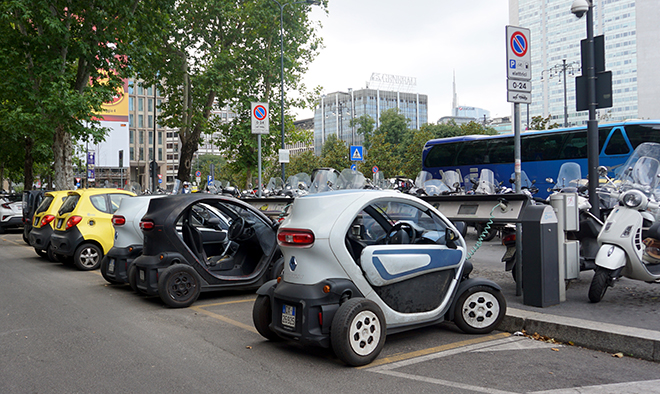Tourists love Europe for its endless variety: just cross a border and you’ll encounter a different language, different architecture, different food – and a different mix of electric vehicles. On this summer’s trip, I visited Amsterdam, which has a huge variety of electrified transportation options; Switzerland, a car-loving country where Teslas are slowly but surely proliferating; and Italy, where the biggest fans of EVs seem to be the police.
Italy is an EV laggard in Europe: in Q1 2019, about 2,160 plug-in vehicles were sold, compared to 14,500 in France and 14,580 in the UK (thanks to InsideEVs for sales figures). However, sales did increase a respectable 15.5% compared to Q1 2018, and are likely to grow much faster now that the government has begun offering purchase subsidies.
Starting in April, Italian car buyers can apply for a subsidy of up to 6,000 euros for an EV, or up to 2,500 for a hybrid. Two-wheeled vehicles are also eligible for rebates. The government has set aside 60 million euros for this year’s subsidies, and that figure will increase to 70 million euros in 2020 and 2021 (as reported by electrive).

In Italy, affluence, and hence interest in EVs, increases as you go farther north. I saw only a couple of EVs in Naples, a respectable number in Rome, and many in Milan. Surprisingly, I saw not a single Tesla in a week of travel (according to EV Sales, Tesla accounts for 17% of the plug-ins sold in Italy so far in 2019, in marked contrast to neighboring Switzerland, where the figure is 42%).
Two factors come to mind to explain the relative lack of Teslinterest: as is the case in Germany (where Tesla has a 12% market share) fans of high performance have several local brands to choose from (Maserati, Ferrari, Lamborghini); and also, in Italian cities, with their famously narrow streets, large cars are simply not very practical.

The Italians do love their tiny cars. The Mini Countryman PHEV is the top-selling plug-in in the country, accounting for 17% of the market. I probably saw more Renault Twizys than any other electric model. I also saw scads of smarts, although only a few of the ones I saw were electric. Ironically, the Fiat 500e, a California compliance car that’s loved by auto reviewers and disowned by its maker, is apparently not sold in Italy.
Fans of the annoying Vespa scooters will be happy to hear that they’re still prevalent, and still as noisy as ever – an electric version of the Vespa has been announced, but I noticed only one electric scooter on my travels. Unlike cars, which are theoretically required to stop at red lights, scooters are not, so I implore you to use all your senses when crossing the strada.

A number of small electric buses are back in operation in Rome. The city’s transit agency, ATAC, bought 60 Gulliver minibuses (5.3 meters long, 22 passenger capacity) from the Italian company Tecnobus in 2010 for 250,000 euros each, as reported by Sustainable Bus. Problems with the batteries caused them to be taken out of service, but as of 2019, 25 of them are back on the streets (the city reportedly spent another 7-9 million to refurbish them). I saw several of the “100% Electric” buses plying the narrow streets of the tourist-thronged old city.

Meanwhile, Milan’s transit agency just ordered 250 electric buses from Poland’s Solaris – one of the largest electric bus orders in Europe to date – and the city plans to phase out diesel buses by 2030.

The most enthusiastic EV adopters in Italy seem to be the police. I saw a Twizy police car on the island of Ischia, several Mitsubishi iMiEVs in the livery of the Carabinieri, and a pair of BMW i3s guarding the Vatican. The Italian police also own a couple of Lamborghinis. They drove one to a recent police conference in Luxembourg, where they were joined by a Tesla Model S belonging to the Luxembourg force and a Model X-100D, one of seven owned by the police in the Swiss city of Basel.




















































































